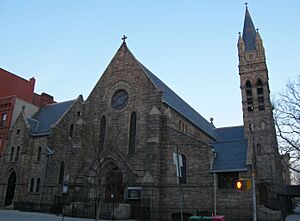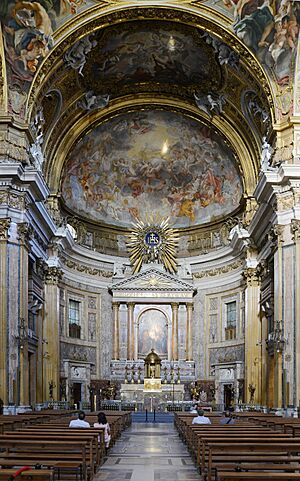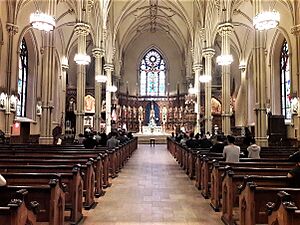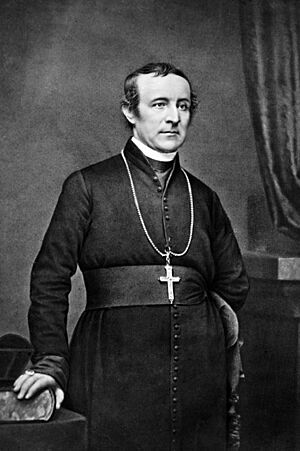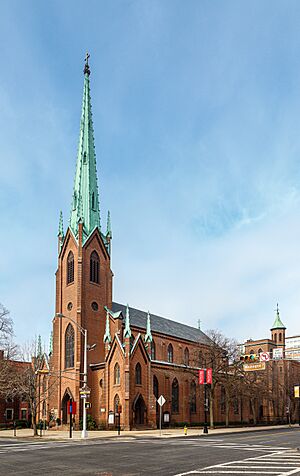James Roosevelt Bayley facts for kids
Quick facts for kids The Most Reverend James Roosevelt Bayley |
|
|---|---|
| Archbishop of Baltimore | |
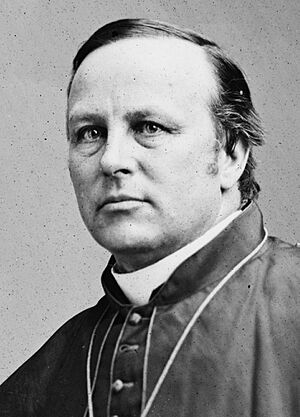 |
|
| See | Baltimore |
| Appointed | June 30, 1872 |
| Enthroned | October 13, 1872 |
| Reign ended | October 3, 1877 |
| Predecessor | Martin John Spalding |
| Successor | James Gibbons |
| Orders | |
| Ordination | March 2, 1844 |
| Consecration | October 30, 1853 by Gaetano Bedini |
| Personal details | |
| Born | August 23, 1814 New York, New York |
| Died | October 3, 1877 (aged 63) Newark, New Jersey |
| Buried | National Shrine of St. Elizabeth Ann Seton |
| Denomination | Roman Catholic Church |
| Previous post | Bishop of Newark (1853–72) |
| Signature | |
James Roosevelt Bayley (born August 23, 1814 – died October 3, 1877) was an important American leader in the Catholic Church. He became the first Bishop of Newark in 1853, serving until 1872. Later, he was the eighth Archbishop of Baltimore from 1872 until his death in 1877.
| Top - 0-9 A B C D E F G H I J K L M N O P Q R S T U V W X Y Z |
Early Life and Education
James Roosevelt Bayley was born in New York City on August 23, 1814. His family had many interesting connections. His grandfather, Dr. Richard Bayley, was a professor at Columbia College. He also created New York's system for keeping sick people separate to stop diseases from spreading.
James's aunt, Elizabeth Ann Seton, was Dr. Bayley's daughter from his first marriage. She later became the first American-born Roman Catholic saint in 1975. James's father, Guy Carleton Bayley, was also a doctor. James's mother, Grace Roosevelt, was related to the famous Roosevelt family. This made James a cousin to the father of future President Franklin D. Roosevelt. He was also a distant cousin of President Theodore Roosevelt.
James was the first child of his parents. He was baptized at Trinity Church in New York City. His family later moved to Mamaroneck in Westchester County.
James went to school in New York and possibly New Jersey. He loved to read and study. In 1828 or 1829, he went to a boarding school called Mount Pleasant Classical Institute in Amherst, Massachusetts.
At this school, James once wanted to join the navy. He even got a special paper to become a midshipman. His classmates were very impressed when he showed up in his uniform. But he changed his mind and decided to focus on his studies instead. His friends often called him "the commodore" as a nickname. He was known for being friendly with everyone.
College Years and New Interests
In 1831, James started studying at Amherst College. He was a good student and enjoyed public speaking in a literary club. After two years, he moved to Washington College in Hartford, Connecticut. Here, he joined another literary group and even helped start a new one.
James finished college in 1835. He first thought about becoming a doctor, like his father and grandfather. But then he changed his mind again. He decided to study to become an Episcopal minister. He studied with a respected clergyman named Dr. Samuel Farmar Jarvis. Dr. Jarvis had a huge library, and James loved reading many old books there.
During his studies, James started to have questions about his faith. He began to wonder about the history of the Christian Church. He read old texts and realized that the Pope might have had a bigger role in the early Church than he had thought.
Journey to Catholicism
While still studying, James became a deacon in the Episcopal Church in 1839. He worked at St. Andrew's Episcopal Church in Harlem. He also helped poor Irish immigrants in the city, who were mostly Catholic. This is where he met Catholic priests and started talking with them about his questions.
He often discussed his doubts with Father John McCloskey, who later became a cardinal. James felt he was close to becoming Catholic but was a bit scared to make the change. He once compared his feelings to jumping a wide ditch: he knew he could do it, but he wouldn't try unless he had to.
Travels and Conversion in Rome
In 1841, James left his church job. His grandfather, worried about his interest in Catholicism, sent him to Rome. He hoped that seeing Rome would make James change his mind. But it had the opposite effect.
James traveled through France, visiting famous places like the Louvre museum and the Palace of Versailles. He kept a journal and wrote about how much he enjoyed seeing historical sites. He then sailed to Italy, visiting cities like Genoa and Naples. He was very impressed by the beautiful churches and ancient ruins he saw.
Finally, James arrived in Rome in February 1842. He visited many famous churches and museums, including St. Peter's Basilica and the Vatican Museums. He met a converted Episcopal clergyman named George L. Haskins, who became a good friend.
In April 1842, James decided to take a special spiritual retreat at the Church of the Gesù in Rome. During this time, he prayed and thought deeply about his faith. On April 28, 1842, he officially became a Catholic. He received confirmation and his first Communion.
After his conversion, James and his friend Haskins visited many holy places in Rome. They even had a special meeting with Pope Gregory XVI. James then traveled through Italy, Switzerland, and France before returning to Paris. From there, he wrote to Bishop John Hughes in New York, saying he wanted to become a Catholic priest.
Becoming a Catholic Priest
In August 1842, James began studying at the Seminary of Saint-Sulpice in Paris to become a priest. His family had mixed reactions to his conversion. His Catholic cousin was happy, but others were sad or confused. James believed his conversion was due to the prayers of his saintly aunt, Elizabeth Ann Seton.
Bishop Hughes visited James in Paris and wanted him to finish his studies back in New York. So, James traveled through Europe, buying rare books for the bishop's library. He visited London, Oxford, and even Ireland, where he heard the famous speaker Daniel O'Connell.
James sailed back to New York in October 1843. After a difficult voyage, his ship got stuck near the coast of New Jersey during a storm. Luckily, a steamer rescued them, and James arrived safely in New York City in November 1843.
He continued his studies at St. John's College (now Fordham University). On March 2, 1844, James Roosevelt Bayley was ordained a priest by Bishop Hughes at St. Patrick's Old Cathedral.
Catholic Priesthood and Service
After becoming a priest, James faced a challenge with his family's inheritance. His grandfather had changed his will to prevent James from receiving money that might support the Catholic Church. James fought this in court, but eventually lost his share of the inheritance.
Bishop Hughes appointed James as the vice-president of St. John's College. He also taught there and took care of small church communities in New Rochelle and Port Chester.
In 1845, James visited Mount Saint Mary's and St. Joseph's in Emmitsburg, Maryland. This was where his aunt, Mother Seton, had founded a religious community. He was deeply moved to see her old room and grave. He felt that her good memory was still very strong there.
James worked hard at St. John's College, especially when the president was away or sick. He helped the college get a special permission from the New York State Legislature to become a university. In 1846, the college was given to the Society of Jesus (Jesuits). James then became a priest in New Brighton, Staten Island. He also helped at a hospital for people with typhus.
Later, Bishop Hughes asked James to be his private secretary. James also helped manage a Catholic newspaper called the Freeman's Journal. He helped make the newspaper financially stable before it was sold in 1848.
First Bishop of Newark
In 1852, American bishops decided to create new dioceses (church regions). On July 29, 1853, Pope Pius IX created the Diocese of Newark and chose James Bayley to be its first bishop. This new diocese covered the entire state of New Jersey.
James was consecrated (made a bishop) on October 30, 1853, in old St. Patrick's Cathedral in New York. Two other new bishops were consecrated with him.
On November 1, 1853, Bishop Bayley officially took charge of his new diocese at St. Patrick's Church in Newark. It was a big job to organize the new diocese. In 1854, there were only 33 churches and 30 priests in New Jersey. Many Catholics were poor immigrants, so James asked for help from church groups in Europe.
Building Catholic Education
Bishop Bayley strongly believed in Catholic education. He said that schools were almost as important as churches. He wanted every Catholic child in New Jersey to attend a Catholic school. To do this, he knew he needed the help of religious sisters.
In 1857, Benedictine Sisters arrived, and he sent women to train with the Sisters of Charity. Many other groups of religious men and women came to the diocese in the following years.
Bishop Bayley also saw the need for a Catholic college. In 1856, Chegary Academy opened in Madison, which later became Seton Hall College. In 1860, the school moved to its current location in South Orange. The college also had a seminary to train new priests. He also helped found the Pontifical North American College in Rome.
By 1865, after ten years as bishop, James Bayley noted great progress. The number of churches and priests had doubled. Many religious communities had joined the diocese. There was a college, a seminary, academies for young ladies, and parish schools in almost every church. He also brought the Jesuits and the Sisters of St. Joseph and St. Dominic to the diocese.
Bishop Bayley was also a strong supporter of the temperance movement, which encouraged people to drink less alcohol. He traveled to Rome and the Holy Land several times for important church events. He served as Bishop of Newark for 19 years.
Archbishop of Baltimore
On July 30, 1872, Bishop Bayley was chosen to become the Archbishop of Baltimore. He was sad to leave Newark, but he took on his new role. In 1875, he had the honor of giving the cardinal's hat to his old friend, Archbishop John McCloskey of New York, who became the first American cardinal. In 1876, he consecrated the Baltimore cathedral, meaning he dedicated it after it was freed from debt.
As archbishop, he made new rules for the clergy (priests) and for things like mixed marriages (between Catholics and non-Catholics) and church music. His health began to fail, so he asked for help. Bishop James Gibbons was appointed to assist him in May 1877.
Archbishop Bayley traveled abroad to try and get better, but it didn't work. He returned to his old home in Newark in August 1877 and passed away on October 3, 1877.
Before he died, he said, "I am Archbishop; I have been Bishop; but I like Father Bayley best of all." This showed his humble spirit. He asked to be buried next to his beloved aunt, Mother Seton, at the convent in Emmitsburg, Maryland.
Writings
James Roosevelt Bayley was interested in history and writing. He believed it was important to collect information about the Catholic Church in the United States.
History of the Catholic Church on the Island of New York
In 1853, he published a book called A Brief Sketch of the Early History of the Catholic Church on the Island of New York. He explained that it wasn't a complete history, but an effort to draw attention to the topic. A second, updated edition was published in 1870.
Memoirs of Simon Gabriel Bruté
He also edited a book called Memoirs of Simon Gabriel Brute, First Bishop of Vincennes (1860). This book was about Simon Bruté, an early bishop. Bayley put together notes and memories from Bruté's life, especially about the French Revolution. Even though he was very busy, he managed to create a book that helped preserve important writings from Bishop Bruté.
Images for kids



